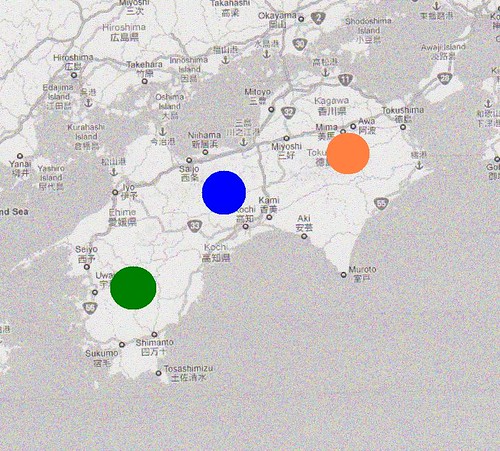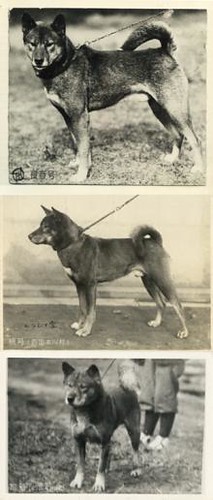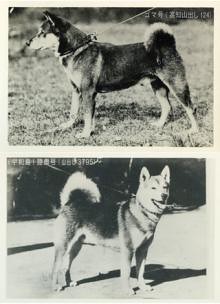Shikoku Bloodlines
The Shikoku breed originated on the island of Shikoku, the smallest of the four main Japanese islands. Shikoku means 'four provinces', and refers to the four former provinces which made up the island: Awa, Tosa, Sanuki, and Iyo. Present day Shikoku is made up of four prefectures, Ehime, Kagawa, Kōchi, and Tokushima.
At the time of the classification of the Shikoku as a breed, there were several 'types' from different regions on the island. One thing all these regions have in common is that they are all very mountainous difficult areas to reach.
The original lines of Shikoku were the Awa, Hongawa, Hata, and Uwajima. The Uwajima and and Hata were virtually indistinguishable and so from early on were lumped together as Hata. The Awa line vanished fairly on, leaving the Hongawa and Hata lines as the 2 bloodlines that make up the modern day Shikoku.

Here is a simple map of Shikoku island with the areas the three lines of Shikoku originated color marked. The Hata line originated in the green area, Hongawa line in the blue, and the Awa line in the orange.
Hongawa-kei (Hongawa line)

The picture above is of 3 famous Hongawa line studs. Listed from top to bottom they are Choushun-gou, Kusu-gou, and Kuma-gou. The Hongawa line is from the area around Hongawa Village. An early history of the area tells us that the area was first settled by professional hunters. Even within this line there were subtle differences in type depending on which village they were from, but I will do my best to list the line's traits.
-Light movement
-Compact, athletic, muscular, with a slightly slimmer build
-Well rounded forehead
-Nice sharp eyeset
-Thinner coat than the Hata line
-Lines between coat colors sometimes blurred
-Higher incidence of B/T
-Skin tight over entire body
Hata-kei (Hata line)

The Hata line is from the south eastern part of the island. The picture above is of 2 famous studs out of this line, Goma-gou (top), and Mutsu-gou (bottom). Here are some of this line's traits.
-Stockier and more thick boned than the Hongawa line
-Less of a 'stop'
-Looser skin over entire body
-Ears set slightly high
-Thicker longer coats than the Hongawa line
-Lines between coat colors very defined
-Higher incidence of white
-Wider spacing between eyes
Most of the Shikoku today are a mix of both lines, although there are a few breeders who maintain relatively pure lines of one type or the other. Most Hata lines today are descended from Matsukaze-gou, a stud that was actually a Hata/Hongawa mix, but carried toward the Hata line.


Comments
Jen
----
I started cracking up at my desk I cried! I didn't expect that one.
Great writeup!!! The more I read about Shikoku, the more I think I would want one possibly in the future. A female I think.